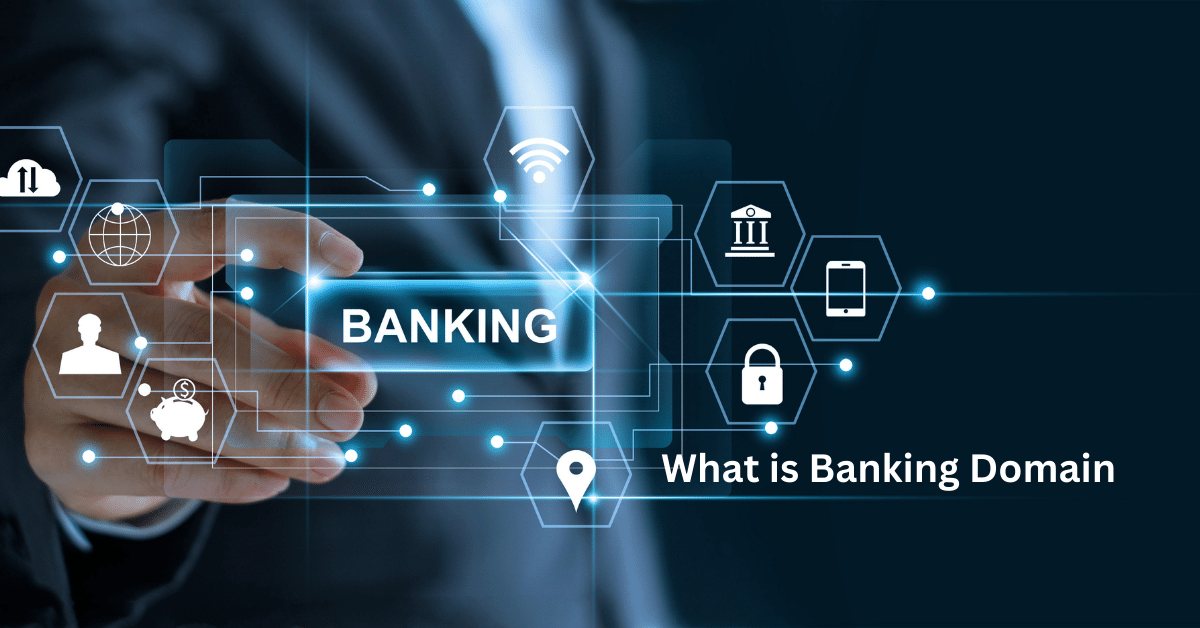The domain of banking is the sector that handles financial purchases, services, and items. Banks are establishments that obtain down payments from customers and provide cash to them. They offer solutions such as inspecting and interest-bearing accounts, finances, credit cards, and financial investment possibilities.
In the elaborate landscape of modern-day financial,”what is domain in banking” transcends plain formality; it is a foundation of the electronic structure that financial institutions rest upon. Comprehending the subtleties of domain names in banking is not simply an issue of IT experience; it’s a tactical imperative. This detailed overview peels off the layers, revealing the crucial duty domains play, their influence on branding, the intricacies of administration, and the essential junction with safety and security. Study this exploration of financial domains and equip on your own with the insights that are necessary in navigating the ever-evolving financial innovation surface.
 what is domain in banking and the Basics?
what is domain in banking and the Basics?
A. Definition of Domain Names
In the world of banking, a “domain name” is not just an internet address; it’s the electronic identification that defines a financial institution’s online existence. It encompasses the personalities adhering to “www” in an internet address, developing a special identifier essential for internet interaction and solutions.
B. Explanation in the Context of Banking
In banking, a domain name acts as the portal to a myriad of online solutions, from electronic banking platforms to interaction portals. It’s not simply a triviality, yet a straightforward address that consumers connect with their economic communications.
C. The Role of Domains in Online Banking
Domain names are the online stores of banks in the digital world. They assist in seamless access to online banking services, instilling dependability and recognition among clients. A well-chosen domain name improves the user experience and establishes a straight web link between the establishment and its customers.
D. Importance of Choosing the Right Domain
Picking a domain name surpasses choosing a catchy name. It entails strategic considerations such as brand name representation, customer recall, and security considerations. The right domain name establishes the tone for a bank’s online presence, affecting client perception and, inevitably, the success of digital efforts.
 Kinds Of Banking Domains
Kinds Of Banking Domains
A. Public Domains with Examples and Analysis
Public domains in banking are those available to the general public and commonly end in familiar expansions like.com,.net, or.org. These domains, such as www.bankname.com, serve as the general public face of the organization.
Analysis: Public domains are critical for brand name visibility and are generally used for advertising and marketing objectives. They are easily unforgettable and assistance in establishing a strong on-line brand name visibility.
B.Private Domains
1.Safety Implications
Private domain names, on the other hand, are limited, commonly utilized for inner communications or specific solutions not meant for public accessibility. These may have expansions like.bank or.internal.
Security Considerations: Private domain names enhance safety by limiting access to delicate details. They contribute in safeguarding inner interaction and critical banking procedures.
2. Benefits for Banking Institutions
Personal domain names provide a series of advantages for financial establishments, including:
Enhanced Security: By restricting access to exclusive domain names minimize the risk of unapproved access and data violations.
Internal Collaboration: They give a safe and secure environment for internal communication and cooperation among the teller.
Specialized Services: Private domains can host specific services or portals that require controlled gain access to, making sure a concentrated and safe user experience.
Recognizing the dichotomy between public and exclusive domains is pivotal for financial institutions to make enlightened choices aligned with their tactical objectives and security demands.
 The Domain Registration Process
The Domain Registration Process
A. Choosing a Domain Registrar
Standards for Selection
Choosing a reputable domain registrar is a vital action in establishing a financial institution’s online existence. Think about adhering to the requirements for making a notified decision:
Reputation: Opt for registrars with a strong reputation for protection, client service, and dependable registration procedures.
Security Features: Ensure the registrar provides robust safety functions, including two-factor authentication and domain name locking, to protect against unauthorized access.
Cost Structure: Evaluate the registrar’s pricing framework, consisting of enrollment fees, renewal prices, and any added fees. Transparency is crucial.
B. Steps in Registering a Banking Domain
Browsing the domain name registration process requires a methodical approach:
1. Domain Availability Check
Begin by examining the schedule of the desired domain. It’s important to make certain the chosen domain is special and lines up with the financial institution’s brand.
2.Registration
When the schedule is verified, proceed with the enrollment process. Give exact details, and take into consideration registering the domain name for a prolonged period to prevent gaps.
3.DNS Configuration
Configure the Domain Name System (DNS) settings to indicate the bank’s servers. This step is essential for ensuring the appropriate routing of internet traffic.
C. Common Challenges and How to Overcome Them
1. Domain name Squatting
Fight domain bowing by proactively registering variants of the financial institution’s name and typical misspellings. This prevents malicious entities from capitalizing on the bank’s brand name.
2.Revival Management
Establish tips for domain revival well in advance to prevent unintentional lapses. Automated revival choices offered by registrars can enhance this procedure.
3.Legal Compliance
Guarantee that the chosen domain abides by legal requirements and hallmark regulations. Failing to comply can lead to legal issues and potential loss of the domain name.
Browsing the domain registration procedure calls for persistence and tactical reasoning. By choosing the best registrar, adhering to a structured registration method, and dealing with the usual obstacles, banks can develop and maintain a robust online presence.
 Domain Name Management Best Practices
Domain Name Management Best Practices
A.Security Measures
1. SSL Certificates and Encryption
Safety and security is paramount in financial domains. Executing Secure Sockets Layer (SSL) certifications ensures encrypted communication between individuals and the financial institution’s web servers.
Importance: SSL certificates protect delicate data, such as login credentials and monetary transactions, from interception by harmful stars.
2.Two-Factor Authentication
Implement two-factor verification (2FA) for domain access. This adds an additional layer of protection by calling for customers to provide two types of identification.
Enhanced Security: 2FA reduces the threat of unauthorized gain access to, providing an added barrier even if login qualifications are endangered.
B. Regular Audits and Updates
1. Periodic Security Audits
Conduct normal safety audits to determine vulnerabilities. This positive approach allows financial institutions to address potential problems before they can be manipulated.
Risk Mitigation: Regular audits lessen the risk of safety violations, ensuring that the domain name remains resistant to advancing cyber dangers.
2.Update Management
Remain alert regarding software application updates, including material monitoring systems, web server software programs, and safety and security plugins. Timely updates spot known vulnerabilities, strengthening the total security position.
Timeliness is key. Delayed updates can subject the domain to recognized susceptibilities, making it vulnerable to exploitation.
C.Monitoring Domain Health
1. Up-time Monitoring
Utilize tools for continuous time monitoring. Swift identification of downtime enables prompt resolution, ensuring undisturbed accessibility to online banking services.
Customer Trust: Consistent uptime improves consumer trust, as customers count on seamless accessibility to banking services.
2. Malware and Phishing Detection
Carry out durable malware and phishing detection devices. These tools aid in determining and counteracting dangers that might endanger the integrity of the domain.
Protecting Users: Detecting and warding off malware and phishing attempts safeguards users from fraudulent activities.
Domain name monitoring in banking calls for a proactive and security-centric strategy. By including SSL certificates, two-factor authentication, conducting normal audits, remaining upgraded with software program spots, and surveillance domain name wellness, financial institutions can fortify their electronic visibility and give a safe online atmosphere for their clients.
 Influence of Domains on Branding
Influence of Domains on Branding
A. Building a Strong Brand Image
1. The Digital First Impression
In the digital age, a bank’s domain name is usually the initial point of call for clients. A well-crafted domain enhances brand identification and creates a favorable preliminary impression.
Consistency Matters: Aligning the domain name with the overall brand message boosts recognition and develops a feeling of trust.
2. Reflecting brand values
Choose a domain name that mirrors the worth and principles of the bank. Whether it’s dependability, technology, or customer-centricity, the domain ought to convey these principles.
Customer Connection: A domain that resonates with the financial institution’s values enhances the psychological link with consumers.
B. Incorporating Branding Elements in Domains
1. Trademark name in the Domain
Include the financial institution’s name in the domain name. This uncomplicated approach reinforces brand recall and streamlines the connection between the brand name and its online presence.
Memorability: A domain name that mirrors the brand is much easier for consumers to remember, promoting repeat check-outs.
2. Visual Branding Elements
Incorporate aesthetic elements such as logo designs or brand name colors right into the web site design connected with the domain name. Consistency in aesthetic branding throughout the internet platforms enhances brand name familiarity.
Visual Cohesion: Visual elements develop a natural online experience, improving brand name recognition and recall.
C.Case Studies of Successful Banking Domains
Checking Out Noteworthy Examples
Explore the study of banks with effective domain techniques. Evaluate how their selection of domain names contributed to brand name acknowledgment, customer trust, and internet success.
Learning from Success: Extract insights from effective examples to educate tactical choices relating to domain options and branding.
Comprehending the impact of domain names on branding is critical for banks intending to establish a strong digital presence. By constructing a regular and reflective brand name photo, including key branding aspects into domain names, and learning from successful case studies, financial institutions can take advantage of their on the internet identity to strengthen consumer partnerships and foster trust.
 Legal Considerations
Legal Considerations
A. Trademarks and Domain Names
Navigating Potential Conflicts
The intersection of hallmarks and domains is a lawful landscape that demands cautious navigating. Make certain that the picked domain name does not infringe on existing hallmarks, staying clear of legal disagreements.
Trademark Searches: Conduct thorough hallmark searches to validate the accessibility of the picked domain and minimize the risk of hallmark violation.
B.Regulatory Compliance
Satisfying Legal Requirements in Domain Management
Conformity with legal laws is non-negotiable for financial domain names. Address the following essential elements to ensure adherence:
Data Protection Laws: Understand and follow information security laws to safeguard customer information and preserve legal honesty.
Domain Ownership Documentation: Keep thorough documents of domain name possession, registration, and renewal to abide by legal requirements and help with dispute resolution if required.
Jurisdictional Considerations: Be aware of jurisdictional nuances, ensuring that the domain monitoring methods align with the lawful frameworks of appropriate areas.
Navigating lawful considerations is important to protect a financial institution’s on-line existence. By proactively attending to trademark issues, staying compliant with information protection legislation, and comprehending administrative factors to consider, financial institutions can mitigate lawful dangers and guarantee the long life of their online domains.
 Domain Renewal and Expired Domains
Domain Renewal and Expired Domains
A. Importance of Timely Renewals
1. Maintaining Online Presence
Timely renewal of a financial domain is critical for maintaining the bank’s on-line presence. Allowing a domain name to expire can lead to disruptions to internet services, impacting consumer dependencies and availability.
Continuous Availability: Renewing domains ensures constant accessibility, preventing unplanned disturbances in electronic banking services.
2. Avoiding Brand Dilution
Non-renewal threatens the loss of a beneficial digital possession and may result in the procurement of the domain name by other entities. This can dilute the brand and create complications among clients.
Brand Continuity: Timely revivals keep brand continuity, reinforcing the financial institution’s identification in the electronic space.
B. Risks and Consequences of Expired Domains
1. Loss of Control
A run-out domain name might be acquired by third parties, causing a loss of control over the digital property. This can cause misuse or redirection to unauthorized web content.
Mitigating Risks: Understanding the risks encourages financial institutions to focus on timely revivals as a safeguard versus prospective misuse.
2. Impact on SEO Rankings
Domain expiration can influence search engine rankings. Search engines might de-index the domain name, impacting the bank’s presence and online discoverability.
SEO Consequences: Maintaining an active domain is crucial for maintaining SEO initiatives and making sure the bank continues to be visible in internet searches.
C. Strategies for Recovering Expired Banking Domains
1. Monitoring Expiry Dates
Carry out a durable system for surveillance domain name expiry days. This ensures that revivals are focused on well in advance, reducing the risk of unintended gaps.
Automation Tools: Utilize automation tools offered by registrars to receive timely suggestions and enhance the renewal process.
2. Redemption Period Strategies
Understand the redemption duration, a grace period after domain name expiration. Create strategies to recover domain names during this period, protecting against irreversible loss.
Proactive Redemption: Taking timely action during the redemption duration is essential for domain name recovery without substantial issues.
Timely renewal is not just a technicality; it’s a tactical vital for financial domains. By acknowledging the relevance of continuous online presence, recognizing the dangers associated with expired domain names, and executing positive renewal techniques, financial institutions can guard their digital assets and maintain a durable online identification.
 Search Engine Optimization and Banking Domains
Search Engine Optimization and Banking Domains
A. Importance of SEO in the Banking Sector
1.Digital Visibility
In an age dominated by online communications, the importance of search engine optimization for financial domains cannot be overemphasized. SEO enhances digital presence, making sure that a financial institution’s online visibility is conveniently visible by potential consumers.
Competitive Edge: Banks with durable SEO strategies acquire a competitive edge in the online landscape, bring in more site visitors and prospective clients.
2. Count on and Credibility
High SEO rankings contribute to the perception of trust and trustworthiness. Customers frequently link top-ranking internet sites with reliability, making SEO a crucial factor in structure and keeping client count.
User Perception: Strong SEO signals communicate authority and integrity, positively influencing the user’s perception of the financial institution’s electronic visibility.
B. Optimizing Domains for Search Engines
1. Search phrase Integration
Incorporate pertinent key words into the domain name, enhancing its placement with search engine formulas. Consider key phrases that show the financial institution’s services, place, and unique worth proposals.
Strategic Keyword Selection: Choosing keywords purposefully adds to enhanced internet search engine positions, enhancing the probability of organic traffic.
2.Mobile Optimization
Optimize banking domain names for mobile phones. With a considerable portion of on-line web traffic stemming from mobile users, mobile-friendly domain names are preferred by internet search engine.
Mobile-First Indexing: Mobile optimization straightens with search engines’ mobile-first indexing, positively affecting SEO positions.
C. Common SEO Mistakes to Avoid in Domain Management
1. Overlooking Local SEO
Neglecting neighborhood SEO can be a substantial oversight for banks. Maximizing for neighborhood search makes certain that the financial institution shows up in pertinent searches within its operational areas.
Local Relevance: Local SEO optimization improves exposure amongst prospective clients in specific geographical areas, a critical factor for financial institutions.
2. Overlooking Regular SEO Audits
Normal SEO audits are essential for identifying and fixing problems. Disregarding these audits can result in undetected troubles that may adversely impact internet search engine positions.
Proactive Maintenance: Conducting normal audits ensures proactive upkeep, resolving problems before they influence SEO efficiency.
Comprehending the symbiotic connection between financial domains and SEO is important for electronic success. By recognizing the importance of SEO in the financial market, optimizing domains for search engines, and staying clear of common SEO errors in domain name administration, banks can place themselves purposefully in the online landscape, bringing in and maintaining a larger audience.
 Domain Name Transfers in Banking
Domain Name Transfers in Banking
A.Reasons for Domain Transfers
1.Re-branding
One usual factor for domain transfers in the banking field is re-branding. When a financial institution undergoes a brand overhaul or merging, transferring to a brand-new domain straightens with the updated identity and messaging.
Consistent Branding: Domain transfers make sure consistency in between the brand’s offline and on-line visibility, staying clear of complications among consumers.
2.Strategic Changes
Strategic shifts, such as expansions right into new markets or the introduction of specialized solutions, may demand domain transfers. This enables the bank’s on the internet identity to mirror its advancing organization methods.
Reflecting Changes: A domain name transfer mirrors the dynamic nature of the financial institution’s operations, keeping the online presence in sync with tactical business choices.
B. Steps Involved in a Smooth Domain Transfer Process
1. Preparation and Strategy
Before launching a domain name transfer, financial institutions need to create a detailed plan. This strategy must include a timeline, communication technique, and a thorough analysis of potential influence on SEO and customer experience.
Risk Mitigation: Planning reduces the threat of interruptions and makes certain a smooth shift, preserving the financial institution’s electronic honesty.
2. Domain Name Verification and Authentication
Verification and verification are essential actions in the transfer process. Verifying possession and validating the transfer request are necessary to protect against unauthorized transfers.
Security Measures: Stringent confirmation safeguards the domain from unauthorized accessibility or destructive transfer efforts.
3. DNS Update and Propagation
Upgrading the Domain Name System (DNS) setups is crucial for rerouting online traffic to the new domain name. DNS breeding may take some time, and banks need to interact with clients to avoid complications.
Communication Transparency: Transparent interaction about DNS updates handles customer assumptions and lowers possible disruptions.
C. Minimizing Disruption to Banking Operations
1.Client Communication
Clear and prompt communication with clients is paramount during a domain transfer. Notifying them of the adjustment, supplying advice, and addressing potential problems contribute to a positive client experience.
Maintaining Trust: Transparent interaction cultivates depend on and commitment, minimizing any kind of negative impact on the consumer partnership.
2.Search engine optimization Considerations
Financial institutions must proactively manage SEO factors to consider during a domain transfer. Carrying out 301 redirects, updating sitemaps, and informing internet search engine concerning the modification promote a seamless change without jeopardizing SEO rankings.
Preserving SEO Investments: Strategic SEO monitoring makes sure that the bank’s previous investments in on the internet visibility are preserved after the domain transfer.
Understanding the factors for domain name transfers, complying with a well-planned procedure, and lessening disruptions through effective interaction and SEO monitoring empowers banks to adapt their online identity in alignment with calculated service modifications.
 Bottom line
Bottom line
A.Recap of Key Points
In this extensive overview, we’ve explored the complex world of financial domains, deciphering their significance, discovering the types of domain names, and browsing the critical processes of enrollment and monitoring. We’ve highlighted the influence of domain names on branding, clarifying the symbiotic relationship in between on the internet identity and customer trust fund.
B.Looking Ahead: Future Trends in Banking Domains
As modern technology remains to progress, so will certainly the landscape of financial domains. Future fads might consist of developments in safety and security methods, cutting-edge methods to domain naming, and a much deeper assimilation of artificial intelligence in domain monitoring. Remaining abreast of these fads will certainly be essential for financial institutions aiming to remain at the forefront of the digital financial realm.
In conclusion, a banking domain is not just a technicality; it’s a critical asset that shapes a bank’s on the internet identification, influences customer perception, and adds to its total success in the electronic landscape. By recognizing the subtleties of domain monitoring, accepting the influence on branding, browsing lawful considerations, and maximizing for SEO, banks can position themselves for a resilient and prosperous electronic future.
 Conclusion
Conclusion
The intricate world of banking domain names is not merely a technological facet yet a tactical foundation shaping the digital identity of financial institutions. This extensive overview has lit up the importance of domains in the financial industry, from their essential duty in branding to the ins and outs of registration, monitoring, and safety. As we look ahead, it appears that remaining attuned to arising trends and technical advancements will be essential for financial institutions to keep a resistant on the internet existence. A financial domain name is more than an address; it is a vibrant property that influences client depend on, brand name perception, and success in the digital landscape. By navigating the intricacies of domain administration, understanding lawful considerations, and enhancing for SEO, financial institutions can build a course toward sustained digital prosperity.
 Frequently Asked Questions (FAQs).
Frequently Asked Questions (FAQs).
1. What is the value of a domain name in banking?
A banking domain name is the on the internet gateway to a financial institution, functioning as the electronic shop for its services. It’s not simply an address; it’s an essential component in establishing count on, enhancing brand name presence, and offering smooth access to online banking solutions.
2.How do I choose the ideal domain name for my financial organization?
Picking the right domain entails tactical factors to consider. Select a name that aligns with your brand, is very easy to bear in mind, and shows your establishment’s worth. Focus on security, stay clear of hallmark problems, and consider the long-term implications of your option.
3.Are there particular safety actions for financial domains?
Absolutely. Safety is critical in financial domain names. Implement SSL certificates for encrypted interaction, apply two-factor authentication, conduct regular safety and security audits, and stay upgraded with the current safety and security procedures to shield delicate client information and preserve trust fund.
4.What steps should be taken if a financial domain expires?
If a financial domain is nearing expiration, take timely action. Establish tips for renewal, use automation devices provided by registrars, and understand the redemption period. Proactive measures can prevent unexpected lapses and possible loss of the domain.
5.How does SEO effect the success of a financial domain name?
Search engine optimization plays a crucial role in the success of a financial domain by boosting digital exposure, building dependencies, and bring in prospective clients. Strategic keyword combination, mobile optimization, and staying clear of usual SEO errors add to greater search engine positions, making sure the bank stays noticeable in on-line searches.
Frequently Asked Questions provide succinct solution to usual inquiries, using visitors quick understandings right into key elements of financial domain names. Recognizing the value of domains, making educated choices, prioritizing safety and security, resolving domain name expiration, and recognizing the influence of SEO are essential to navigating the complexities of financial domains efficiently.
